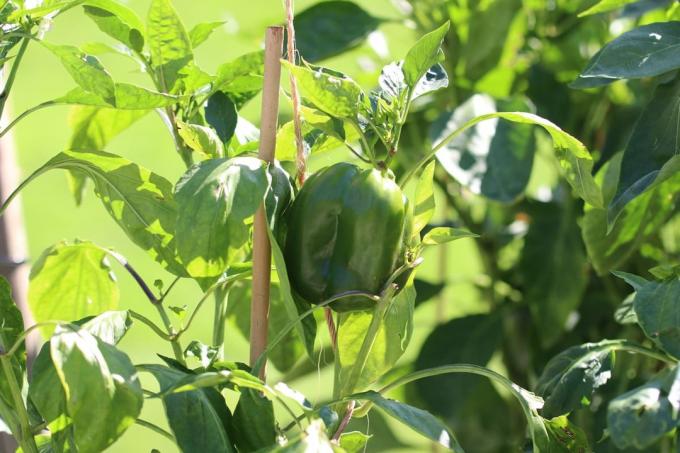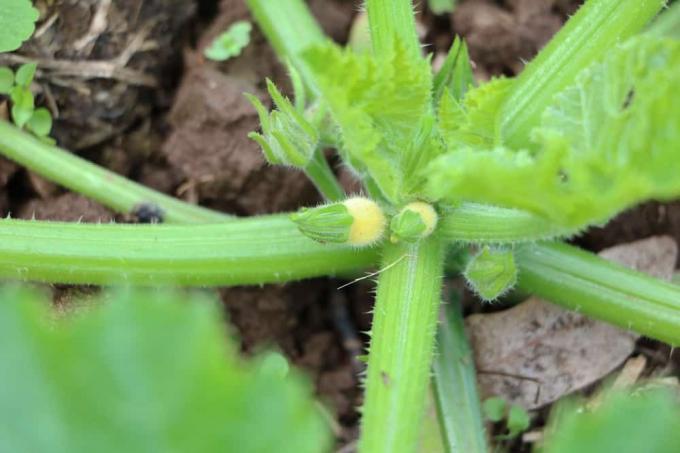

Table of contents
- F1 hybrids
- "Real" seeds
- Required quantity
- store seeds
- germination test
- time for sowing
- potting soil
- seed pots
- Instructions for sowing
- Location
- Care
- pricking
- Sequence
- Care of the young plants
- plant out
True seed chili varieties contain many seeds, which are usually removed during preparation. You should keep a few of these. Each one of them can turn into a green, richly bearing plant in the following year. But there are also promising seeds on the market. Beginning with the sowing, a few steps await the gardener so that the field can be conquered quickly in May.
F1 hybrids
The first question when growing a chilli is not just about the right variety, so that the flesh and the degree of spiciness correspond to your own preferences. The decision of whether to use "true" seeds or F1 hybrids is also a fundamental one.
- almost exclusively F1 hybrids are now commercially available
- Above all, they promise high yields
The seeds of the harvested chili peppers are not varietal, much to the delight of the agricultural industry. Seeds have to be bought anew every year to reproduce them. Apart from the fact that only worthwhile varieties find a permanent place on the market.
"Real" seeds

If you want to preserve the biodiversity of nature and also want to grow unusual, old chilli varieties, you will find them in special online shops or at seed banks. From the later harvest, you can get seeds for further propagation yourself at any time, completely free of charge. The agricultural industry argues with a higher yield of the F1 varieties, but are they also packed to the brim with valuable ingredients like the true-to-seed varieties? And do we want to encourage this dependency?
Required quantity
Homegrown seeds are free and theoretically available in abundance, while store-bought seeds are portioned and expensive. Before sowing, the question arises, how many seeds are necessary?
- the size of the available bed area decides
- calculate a radius of 30 to 40 cm per chili plant
- plan a reserve as not all seeds will germinate
Tip:
Store-bought packets contain 20 to 100 seeds, but they don't need to be sown all at once. Their germination is usually 3-4 years.
store seeds
The seeds must be stored properly until they are sown so that their quality does not suffer. It is best to keep it tightly sealed, cool, dry and dark. Seeds that you remove from ripe pods should be dried beforehand.
germination test
The germination capacity of seeds decreases more and more over the years. If you are not sure whether the chili seeds are still germinable, you can do a germination test in January.
- moisten a few layers of kitchen paper
- to put on a plate
- spread some seeds on it
- Stretch cling film over it
- poke a few holes in it
- set up warm
After two to four weeks, depending on the variety, you can see how many seeds have actually germinated. This result can be applied to all seeds. If the germination rate is low, you have to sow more seeds or even get new seeds.
time for sowing
Chili, botanically Capsicum annuum, needs temperatures above 20 degrees Celsius to germinate. The seeds can therefore only be sown outdoors in this country from mid-May, because only then is there no longer any risk of frost. Unfortunately, there is only one problem: the long time until harvest.
- most types of chili take a long time to ripen
- about 90 days after sowing
- some varieties even 120 days
If you do the math carefully, you will quickly find that the harvest does not start until August or August. September falls. That's much too late, especially since the season can't last much longer due to the climate.
If you want to harvest earlier and longer, you must not sow the chili seeds directly in the bed, but send young chilli plants to the start in May. The seeds must first germinate in a suitable room.
- start sowing in February
- at the latest in March
Tip:
For those who don't have the time or opportunity to sow early: There are some chili varieties that are ready to harvest after just 50 to 70 days. Ask about it in specialist shops.
potting soil

It is easiest if you buy potting soil from a specialist shop that is low in nutrients and largely free of harmful germs. But chillies also germinate in normal garden soil. You can sterilize them in the oven at 200 degrees for 30 minutes beforehand so that all harmful germs are killed.
seed pots
When it comes to the early sowing of seeds, the trade has a lot to offer. Special growing pots, multi-pot trays or small, heatable greenhouses are included. They certainly have their advantages, but they are not a must. Chili seeds also germinate in "old" pots. It doesn't matter whether it's empty yoghurt cups, old flowerpots or other bowls. You only have to meet the following requirements:
- be big enough
- provided with holes
- be washed clean
You can use several small pots of about 10 cm, in which you sow 5-6 seeds each, or you can use a larger container that offers enough space for all seeds.
Tip:
If you sow different varieties, you should use a separate seed pot for each variety so that you later know exactly which plantlet you are holding when planting.
Instructions for sowing
- Soak the seeds in warm water for a few hours where they can swell. Use separate containers for different strains so the seeds don't get mixed up.
- Fill the seed pots with soil, leaving only about 2 cm.
- Water the soil until it is completely soaked.
- Spread the seeds on it. The distance between individual seeds should be about 2 cm.
- Cover the seeds with an approx. 5 mm thick layer of soil.
- Moisten the top layer of soil with lukewarm water. It is best to use a spray bottle for this so that the seeds are not washed out of their position.
- Cover the pots with cling film to keep the soil from drying out.
Location
Place the seed pots in a light and warm place. A window seat above the heater is ideal. The temperature should be above 20 degrees. The higher the temperature, the faster the seeds will germinate. At 30 degrees Celsius, the germination period is about 8-14 days.
Care
Keep an eye on the sowing so that the seeds develop into vigorous plantlets. The soil should remain slightly moist throughout. If there is waterlogging, mold can spread quickly. Air the cover once a day until the seeds have germinated, after which it can be removed altogether.
pricking
About four weeks after sowing, the chilli seedlings will have formed their first leaves, then it is time to prick them out. If you wait too long, the plants will grow taller to get more light. The stems remain thin and weak.
Material for pricking
To prick chillies you will need:
- small pots about 10 cm in diameter
- made of plastic, clay or some other material
- fresh potting soil
- prick stick

The pricking stick is helpful for separating the seedlings from one another and getting them out of the seed tray without damaging them. A spoon handle also performs the same service.
Tip:
You can make cheap potting soil yourself by mixing garden soil from deeper layers, medium-grain sand and mature compost.
Sequence
- Moisten the soil in the seed tray, because then the chilli plants will separate more easily.
- Fill all the pots with potting soil, leaving 1 cm free.
- Poke a 3-4 cm deep hole in the middle with the pricking stick, into which the seedling will later come.
- Among all the seedlings, choose those that have developed best.
- Poke close to the seedling with the prodding stick and gently pry it out of the soil. Leave as many roots as possible.
- Place the seedling in the prepared planting hole up to the cotyledons. The roots should not bend to the side.
- Prick out as many seedling as you need, one at a time.
- Press down the soil and water gently.
- Place all the pots in a light location that will not be directly exposed to the sun for the next few days.
Care of the young plants
The transplanted plants need a lot of light, high humidity and warmth of around 20 to 22 degrees. If they cannot stand very brightly, the ambient temperature should also be cooler, otherwise they will spoil. Start fertilizing after two weeks and gradually get the plants used to the fresh air.
A notice:
If the plants are growing very vigorously, it may be necessary to prick them out a second time in larger pots.
plant out
After the ice saints, the chili plants are finally allowed to go outside permanently. Don't let warm days tempt you to plant them out earlier. At night, the temperature can drop below 0 degrees and destroy the plants. Cold temperatures can also stunt growth, causing plants to delay development. A chili plant does not necessarily have to grow in a bed. Large containers are also ideal for these vegetables.
 Home editorial office
Home editorial office
Find out more about paprika, chili & Co

Grow peppers yourself from seeds: instructions
Growing peppers yourself is easy, because the popular vegetable can easily be propagated from seeds. In this article you will find out how the sowing works best.

12 good neighbors of peppers | mixed culture
The Germans love peppers. On average, more than four kilograms are consumed per person per year. In the garden, the vitamin-rich vegetable thrives in sunny spots. If you choose the right plant neighbors, you can look forward to a high yield.

Sowing peppers: sowing according to the lunar calendar 2023
Red, yellow or green, pointed or round, mild or hot, paprika is one of the most popular types of vegetables. Would you like to grow the healthy vegetables in your own garden? If you pay attention to the needs of the plant and the lunar calendar, you will benefit from a rich harvest!

Cut/pinch out the pepper plant | 5 tips for pruning
Sweet, hot, pointed or plump, which hobby gardener does not like them, the crispy fresh or fiery peppers. Be it the mildly fruity sweet peppers or the spiced peppers with different degrees of spiciness. Cultivation and care are the same. There is only a small difference in the cut.

Prick the peppers: Instructions | Soil and pot size basics
To germinate, many pepper seeds may be close together. But as soon as the seedlings rise from the ground and form the first green leaves, they should be separated from each other. Transplanting them into their own pots gives them more space and therefore better growing conditions.

Climbing zucchini: plants, care and ideas for zucchini trellises
Climbing courgettes are practical both on the balcony and in the garden, as they only take up little space in width and can therefore be grown in a space-saving manner. Here we reveal what is important when it comes to care.
